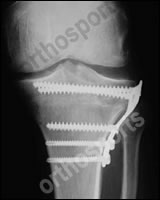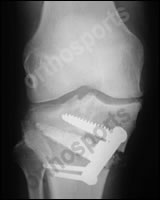Inside This section
Osteotomy
Osteotomy literally means cutting of bone. During an osteotomy the bone is cut and its position is changed in order to shift the pressures from one part of a joint to another. This procedure is performed more commonly in the knee than the hip.
In the knee it is done for arthritis affecting only one side of the joint. The idea is that the bone is cut and realigned to take pressure off the affected part and put onto a better part of the joint (Hopefully taking away the pain). In the hip it is done for disorders such as avascular necrosis, dysplasia, following trauma, childhood deformities. An osteotomy can be performed around the hip in the pelvis or the top of the femur and in the knee in the femur just above the knee or tibia just below the knee. Osteotomies in the knee are usually done to correct knock knee or bowed legs.
Indications
- Patients are generally young (under 55 years of age) and active
- They have arthritis affecting one part of the joint
- They have a good range of motion of the joint
- They have good bone quality
- They are able to non weight bear on crutches
- They are committed to rehabilitation
Contraindications
- Inflammatory arthritis
- Infection
- More than one compartment involved
- Stiffness
- Obesity
- Over 65 years of age
Osteotomy of the Knee (High Tibial Osteotomy)
What Is Done?
Each osteotomy is individualised to the needs of the patient. Xrays are important to plan any osteotomy and a lot of preparation goes into it. The degree of correction is calculated prior to surgery.
It is possible to perform several different types of osteotomies:
- Closing Wedge – where a triangular piece of bone is cut out,
- Opening Wedge – where the bone is spread open, and,
- Dome Osteotomies – where the bone is cut in a semicircular shape.
All these osteotomies need to be fixed afterwards with some form of device, usually a plate and screws. Some may require a bone graft.


What Are The Complications?
Anaesthetic Complications can occur but are statistically small .
Surgical Complications
General Complications
Specific complications again are rare and the utmost care is taken during surgery to avoid them. The following is a list of the well described complications but rare and unusual complications can occur. Most of these complications are treatable and do not lead to long term problems. Potential complications include but are not limited to:
- Excessive swelling and bruising of the leg.
- Infection – the procedure is done using antibiotic prophylaxis and in a sterile operating environment to reduce the risk of infection. Treatment involves either oral or intravenous antibiotics and may involve further operations.
- Joint stiffness – can result from scar tissue within or around the joint resulting in loss of motion.
- Damage to nerves or vessels – there are small nerves under the skin which cannot be avoided and cutting them can lead to areas of numbness in the skin below the knee. This numbness generally reduces in size with time and doesn’t cause any functional disability. Occasionally damage to more important structures can occur leading to more significant areas of numbness and muscle weakness below the knee.
- Failure to correct deformity or overcorrection. One problem, especially in women, is that the appearance of the leg can be unsightly and be different from the other side. The position can also change over time.
- Hardware problems – the osteotomy is fixed into place with various devices. These devices can occasionally cause irritation to surrounding structures and require removal.
- Reflex sympathetic dystrophy – this is a rare condition, the mechanism of which is not fully understood. It involves an overactivity of the nerves in the leg causing unexplained and excessive pain.
- Deep Venous Thrombosis – clots in the leg which may require medical management in the form of injections or tablets to thin the blood. Very rarely these can travel to the lungs (pulmonary embolus) causing respiratory difficulties or even death.
- Compartment syndrome – an extremely rare condition which is due to excessive swelling in the leg cutting off the circulation to the muscles. This requires a fasciotomy operation to relieve this pressure.
- Ongoing Pain – this can be unpredictable.
- Limp.
- Unsightly scar or wound breakdown.
What Are The Results?
Each patient is individual and there are many types of osteotomy so this needs to be discussed with your surgeon. In general around the knee, 60% – 75% of osteotomies will still be functioning very well ten years later.
